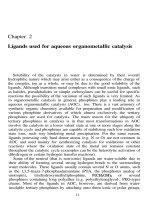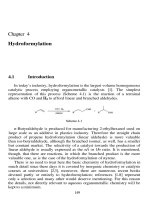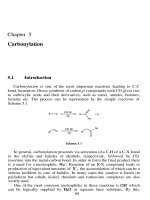- Trang chủ >>
- Khoa Học Tự Nhiên >>
- Vật lý
Tài liệu Chapter XVIII Diffraction of light pdf
Bạn đang xem bản rút gọn của tài liệu. Xem và tải ngay bản đầy đủ của tài liệu tại đây (540.41 KB, 38 trang )
GENERAL PHYSICS III
GENERAL PHYSICS III
Optics
&
Quantum Physics
Chapter XVIII
Chapter XVIII
Diffraction of light
Diffraction of light
§1. Fresnel diffraction
§2. Fraunhofer diffraction
§3. X-ray diffraction from crystals
“Diffraction” of light can be understood as any deviation of light rays
from their geometrical propagation line (that is straight in a homogeneuos
material)
Point source
Area of
illuminaton
Geometrical
shadow
Straight
edge
An example (shown in the picture):
The edge of shadow is never
perfectly sharp. Some light
appears in the geometrical
shadow, and there are dark
and light fringers in the area of
illumination.
Diffraction of light can be considered as an argument for wave
characteristics of light, like other wave processes (sound, etc.)
§1. Fresnel diffraction:
We consider separatly two kinds of diffraction:
Near-field diffraction → Fresnel diffraction
Far-field diffraction → Fraunhofer diffraction
S
Screen
Screen with a
circular aperture
1.1 Diffraction through a circular aperture:
According to geometric optics,
the image of a circular aperture
in the screen must be a light circular
dick with a perfectly sharp edge.
But it’s not so.
a
b
For analyzing this phenomenon, we use the Huyghen-Fresnel principle.
1.2 Huygen-Fresnel principle:
For analyzing properties of wave processes, Huygen introduced the
concept of wave front, and the rule how to draw a wave front from
known sharp of at some former time
Huygen’s principle (1678):
All points on wavefront are point
sources for spherical secondary
wavelets with speed, frequency
that equal to initial wave. The wave front at a
later time is the envelope of these wavelets.
Wavefront at
t=0
Wavefront at
time t
Basing on Huygen’s principle one can interpret diffraction as
interference of light from secondary sources. For example, every
point of circular aperture becomes a secondary source, and what we
see in the screen is the interference of secondary sources.
But this interpretation is only qualitively, for a quantitive analyze,
we need more. It has not been known from Huygen’s principle:
how can determine the amplitude and the phase of secondary waves ?
Fresnel’s complementary statement:
Observation
point
Wave
front
Fresnel states that for the vibration
at P due to waves from the secondary
source dS we have the following formula:
dS
where
a
0
&
(t +
)
→ the amplitude &
phase of vibration of secondary sources at dS on the wave front S
K
→ a coefficient which depends on the angle
K
decreases
as
increases;
K = 0
when
= / 2
The total vibration
at
P
is
1.3 Analysis of diffraction through circular aperture:
Having Huygen-Fresnel principle we tend to analyze the phenomenon
of diffraction through a circular aperture.
1.3.1. The Frsenel method to devide a spherical wave front into
adjacent zones (Fresnel zones):
1-th zone
2-nd zone
3-rd zone
4-th zone
Calculate the area of the
m-th zone:
where S
m
is the area of
the m-th spherical segment:
(h
m
– the hight of segment)
h
m
is defined from the following equation:
Remark: The area of a zone does not depend on m. It means that the
areas of zones are approximatly the same (for values of m that are not
large).
We have also the formula for the radius of the m-zone:
r
m
is proportional to
From the Fresnel formula for dξand all the described properties of
Fresnel zones we can lead to the following formula for the amplitudes
of vibrations at P which are sent from Fresnel spherical zones :
from the 1-st zone
from the m-th zone
,,,
…
Further, the phases of vibrations from two adjacent zones have the
phase difference → we can write for the total amplitude of
vibrations at P:
It equals a half of amplitude due to
the 1-st zone !
1.3.2 Come back to the experiment of diffraction through an aperture:
→ What happens if there is a screen with circular aperture in the
light propagation line ?
Suppose that the part of wave front based on the aperture
incorporates m zones:
+ for odd m
- for even m
(odd m)
(even m)
Screen with aperture
Screen
y y
Conclusions of diffraction picture on the screen:
Depending on the size of aperture, the number of open zones m is
odd or even:
• If m is odd → at the center point P there is a light spot
• If m is even → at the center point P there is a dark spot
Besides the center point P, at other points in the screen, the light
intensity has maxima or minima, depending on the distance from
the center point P.
Owing to the symmetry, light & dark fringers on the screen are
circles centered at P.
Comparison the Fresnel zone pictures according to
a) the axis SP; b) the axis SP’; c) the axis SP”
a)
b)
c)
To understand why the light intensity is different at P, P’ & P”
we describe the Fresnel zones for three cases, and make a
comparison. Here we suppose that the aperture exposes 3 zones.
§2. Fraunhofer diffraction:
We have studied an example of Fresnel diffraction. In Fresnel (or
near-field) diffraction, we deal with spherical wave (wave front is
spherical).
Now we consider Fraunhofer (or far-field) diffraction that concerns
plane waves. An example is diffraction of a beam of prallel rays on
a single slit, or multiple slits.
2.1
Single
Single
-
-
slit Diffraction:
slit Diffraction:
Consider a plane light wave that comes to a slit. Suppose that
slit is very long (or its length is much larger the width)
2.1.1 Diffraction minima:
First we define the location of minima in the screen
• At this angle the light from the
top and the
middle
of the slit
destructively interfere. Below two
these points we can find
corresponding pairs from which two
waves destructively interfere at P.
Location of nth-minimum:
P
Incident Wave
(wavelength )
y
L
a
a/2
min
sin
2 2
a
min
sin
a
min,
sin
n
n
a
min,2
sin
4 2
a
min,2
2
sin
a
a/4
(n =±1, ±2,…)
The second minimum is at an angle
such that the light from the top and
a point at a/4 destructively interfere:
O
• For small → n-th minimum corresponds to
, )2,1(, n
a
n
n
, )2,1(, n
a
n
Ly
n
and the corresponding y- coordinates in the screen are
L
a
a
• Note that for n = 0, that is y = 0, it is the point O in the screen,
Light from entire slit arrives at O in phase. Here we have a bright
fringer with the width 2/a (twice in width than other bright fringers).
2.1.2 Intensity in the single-slit pattern:
By using the phasor diagram method, we can have a detail analysis
To analyze diffraction, we treat it as
interference of light from strips
Model the single slit as M strips with
spacing between the strips of a/M.
There are phase differences between
waves coming from adjacent strips
The phase difference between first and
last source is given by
a
= (asin
Screen
(far away)
a
= a sina
a
L >> a implies rays are
parallel.
L
P
A
P
A
0
The amplitude at O (in phase)
• Taking M = 10, we draw the phasor diagrams
A
0
Vibration vectors at O
and at P
As we let M , the polygon becomes
the arc of a circle.
The radius of the circle is determined
by the relation between angle and
arc length: = A
o
/R.
2
0
2
0
/)sin(
/)sin(sin
2/
)2/sin(
a
a
III
Intensity is related to amplitude: I = A
2
. So, here’s the final answer:
Remember: 2(
a
2a sin
A
o
a
2
A
R
Trigonometry: A/2 = R sin(/2)
With R = A
o
/, A = (2A
o
/sin(/2)
2/
)2/sin(
0
AA
• The graph of the intensity versus
sinis shown in picture
I
0
I
-2a –a a 2a
sin
• Intensity maxima:
Consider the obtained equation
as a function I = I () we can find
maxima by solving dI/d= 0.
This is a transcendental equation that has to be solved numerically.
Here is the results:
Example:
Suppose that when we pass red light (= 600 nm) through a slit of
width a, the width of the spot (the distance between the first zeros
on each side of the bright peak) is W = 1 cm on a screen that is L = 2m
behind the slit. How wide is the slit?
Solution:
The angle to the first zero is: = ± /a
1 cm = W
L = 2 m
a
Solve for a: a = 2L/W = (4m)(610
-7
m) /(10
-2
m)
= 2.410
-4
m = 0.24 mm
W = 2 Ltan L2L/a
(use tan
2.2 Multiple-slit diffraction:
y
L
d
Intensity for N equally spaced slits can be found from phasor
diagram analysis
We can consider multiple slit diffraction
as a combine of
• multiple slit interference
• single slit diffraction from every slit
2.2.1 Multiple slit interference:
We denote
+ by d the distance between adjacent slits
+ by a the width of every slit
a
Draw normal lines bisecting the phasors. They intersect, defining R as
shown:
2
2
1
sinR
A
2
2
N
sinR
A
N
)/sin(
)
/
N
sin(
AA
N
2
2
1
Solve for R
and plug in
here:
Result:
2
1
2
2
)/sin(
)/Nsin(
II
N
N
A
N
R
A
1
R
N slits:
A
1
/2
R
R
2
2
2
2
2
N
: phase difference between waves that come from
two adjacent slits, = 2d/= (2dsin)/
Combine:
Combine:
Slit Interference + Diffraction
Slit Interference + Diffraction
Multi-slit Interference,
Remember: = d sin/d /
a
a sina
2
01
2/
)2/sin(
II
2
1
)2/sin(
)2/sin(
N
II
N
22
0
)2/sin(
)2/Nsin(
2/
)2/sin(
II
angle between adjacent phasors
angle between 1st and last phasor
(for plane-wave sources, I
1
= constant)
to obtainTotal Interference Pattern,
Single-slit Diffraction,
Example:
Example:
Light of wavelength is incident on an N-slit
system with slit width a and slit spacing d.
1. The intensity I as a function of y at a viewing
screen located a distance L from the slits is
shown to the right. What is N? (L >> d, y, a)
(a) N = 2
(b) N = 3
(c) N =4
I
I
max
Y (cm)
(a) N = 2
(b) N = 3 (c) N =4
N is determined from the number of minima between two principal
maxima. Here, there are two minima between principal maxima.
Therefore, N = 3 .









